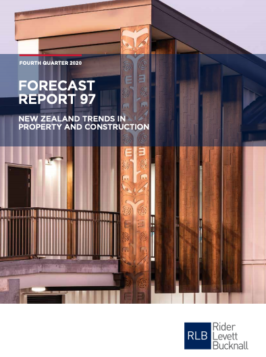According to the Rider Levett Bucknall (RLB) Forecast 97 report – New Zealand Trends in Property and Construction – prospects for the building sector have improved markedly over the second half of 2020 and the first quarter of 2021.
Prepared by the New Zealand Institute of Economic Research (Inc.) (NZIER) exclusively for Rider Levett Bucknall (RLB), Forecast 97 found that the property and construction sector’s longer-term outlook is positive due to the low-interest rate environment, RMA reforms, climate change adaptation and extensive infrastructure programs.
RLB Director Grant Watkins said, ‘These indicators are in line with the continued increase in consent issuance, particularly for dwellings. The increase in residential construction demand reflects the effects of strong population growth in recent years, with record-low mortgage rates also supporting strong demand for housing.’
Medium-density housing drives growth in residential construction
He continued, ‘Strong demand for medium-density housing such as townhouses continues to drive the growth in residential construction demand. Meanwhile, demand for high-density housing such as apartments is starting to pick up again after a decline over much of 2020.’
‘We expect the continued low-interest rate environment will support demand for residential construction over the coming years, with demand for multi-unit dwellings likely to be stronger given the shortage of centrally located land,’ he added.
Auckland leads the way due to migration-led population growth
According to RLB’s Forecast 97, the demand for construction has been particularly strong in Auckland, reflecting the region’s concentration of migration-led population growth over the past decade.
The annual number of dwelling consents issued in Auckland reached new record highs in the 2020 year, despite the disruptions of the Alert Level lockdowns. Dwelling consent issuance in Canterbury has also been rising, in contrast to the easing in Wellington and Waikato. With house prices increasing strongly across the regions, RLB expects this will support a broad-based increase in demand for residential construction.
Increased manufacturing to underpin demand for industrial buildings
Storage buildings led the demand for non-residential construction over the past year. RLB expects increased manufacturing output will underpin robust demand for industrial buildings over the coming year.
Grant noted, ‘Weekly light vehicle traffic flows rose back close to pre-lockdown levels in recent months, suggesting people headed back to the office and largely resumed normal activities as New Zealand moved down the alert levels.’
‘However, there are signs office workers continued to work from home for at least some days of the week even as lockdown restrictions were relaxed,’ he added.
Construction demand weak in accommodation and retail sectors
Meanwhile, Forecast 97 noted the severe impact of continued border restrictions on tourism activity is reducing demand for the construction of new accommodation and retail outlets. With the government indicating borders will likely remain closed until 2022, we expect non-residential construction demand in these sectors will remain weak over the coming year.
Although the recovery in consumer confidence points to an improving outlook for retail spending, the growing shift towards online shopping will weigh on demand for bricks and mortar shops over the longer term.
Auckland office vacancies Increase, while Wellington less impacted by pandemic
Whilst non-residential consent issuance in Auckland increased in recent months, on an annual basis it is much lower than year ago levels. Over the past year, the decline in Auckland non-residential consent issuance was driven by reduced demand for retail outlets and office buildings.
Grant continued, ‘Auckland demand for health facilities and social and education buildings also declined over the past year. The marked increase in office vacancy in the Auckland CBD over 2020 should weigh on construction demand for office buildings over the coming years.’
‘The increase in office vacancy in Wellington has been more muted, reflecting the dominance of the public sector which has meant the region has been more sheltered from the effects of the COVID-19 outbreak. Non-residential consent issuance for office buildings in Wellington increased strongly over the past year,’ he said.
In contrast, demand for health facilities and social buildings declined. Non-residential consent issuance in Canterbury fell sharply over the past year, driven by a broad-based decline across most sectors including accommodation, education and social buildings, and storage buildings.
Labour shortages to create wage growth
According to RLB, the strong rebound in construction demand has led to high demand for contractors in the sector, with building sector firms reporting increased difficulty in finding labour. These labour shortages should underpin a pick-up in wage growth over the coming years. Increased statutory holidays and sick leave provisions will also add to labour costs.
Meanwhile, measures aimed at lowering carbon emissions will likely boost initial capital costs of construction, balanced against cost savings over the operational life of the buildings. The net impact on development costs will depend largely on the measures specifically implemented for each development.
National average cost escalation to rise by end of year
RLB expects these factors will drive a lift in construction cost escalation over 2021, with the national average annual cost escalation to rise from a trough of 1 per cent in March 2021 to 2.3 per cent by the end of this year. Beyond that, a more modest increase in cost escalation is forecast towards 3 per cent by 2023.
Grant concluded, ‘We do have a major resource issue in a large number of centres around the country and prices are escalating quickly due to reduced market competition, COVID-related delays, as well as actual cost inflation.’
FURTHER INFORMATION:



